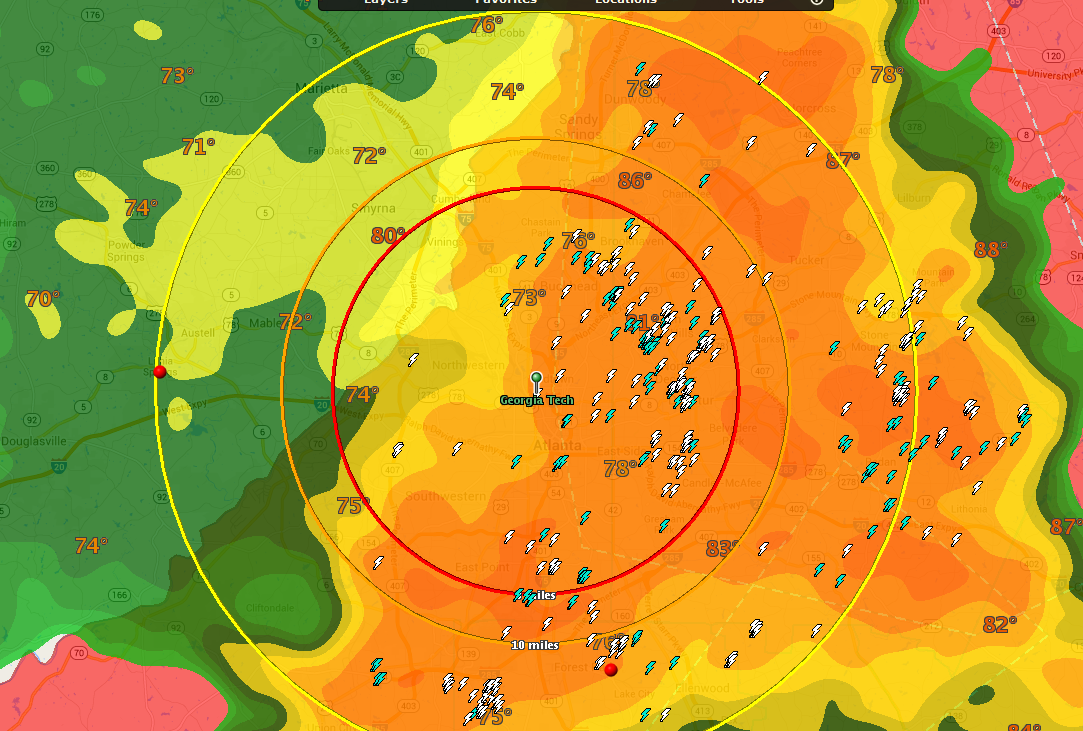Monitoring system provides weather intel to help keep the campus community safe

This actual screen shot from the WeatherSentry radar shows lightning as it approaches the Georgia Tech campus from the 15-, 10- and 8-mile range.
The familiar adage, “Everyone talks about the weather, but nobody ever seems to do anything about it,” may hold true for the general population, but for the Georgia Tech Police Department’s Office of Emergency Preparedness (OEP), monitoring campus weather conditions is a year-round responsibility.
“In terms of significant threats to the safety of Georgia Tech, weather ranks as a top concern,” said Emergency Preparedness Director Andy Altizer.
To monitor for severe weather conditions threatening the campus community, Emergency Preparedness uses WeatherSentry, an Internet-based lightning detection and weather monitoring system that provides weather alerts tailored specifically to Georgia Tech’s Atlanta campus.
According to Project Coordinator Will Smith, WeatherSentry pulls information from the National Weather Service, so all warnings, watches and advisories that specifically impact the campus generate an alert through the system. For example, text alerts are sent to OEP and GTPD command staff and watch commanders.
While public safety and other staff members depend on the service to monitor severe weather conditions, the system also provides a critical tool for those on campus who are responsible for outdoor events and other occasions that might be impacted by the weather.
Monitoring lightning is an important function, particularly for major sporting events. WeatherSentry provides detailed alerts when lightning is detected within advisory, caution and warning areas of campus, currently set at 15, 10 and 8 miles, respectively. Alerts, sent via text and email, provide details on the range and direction of the lightning from the center of campus. (For example, an alert might note, “lightning has occurred within your warning area 5.6 miles to the northeast.”) Using this 8-mile warning radius, the Athletic Association and the Campus Recreation Center, for instance, are able to decide when athletic events and outdoor recreational activities should be suspended.
“For major events, we can provide temporary access for organizers to receive alerts for lightning as it approaches campus in the 15-, 10- and 8-mile range,” said Smith.
The notification system is available to anyone on campus who is responsible for managing events or any member of the campus community who is interested in following severe weather conditions that might impact campus. For those who simply prefer knowing about ongoing weather updates, alerts are provided when lightning is detected within an 8-mile radius.
“WeatherSentry updates are not intended to take the place of our siren warning system and the Georgia Tech Emergency Notification System (GTENS),” said Smith. “GTENS allows students, faculty and staff to receive time-sensitive emergency messages in the form of an email, voice mail and text messages when there is action required.”
“Weather is no different from potential dangerous situations where everyone must take responsibility,” said Altizer. “Staying alert to changing weather situations, and adhering to the old saying, ‘when thunder roars, go indoors,’ remains important even with today’s technology.”